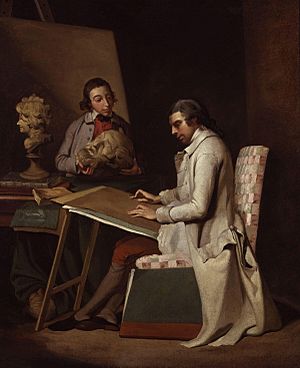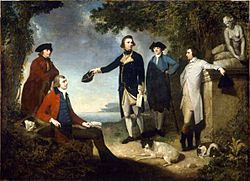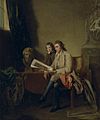John Hamilton Mortimer facts for kids
Quick facts for kids
John Hamilton Mortimer
|
|
|---|---|

Self-portrait of John Hamilton Mortimer with a student, circa 1765
|
|
| Born | 17 September 1740 Eastbourne, U.K.
|
| Died | 4 February 1779 (aged 38) |
| Education | Duke of Richmond's Academy |
| Occupation | Artist |
| Spouse(s) | Jane Hurrel |
John Hamilton Mortimer (born September 17, 1740 – died February 4, 1779) was a British artist. He was known for painting people and landscapes, and for making prints. His art often showed scenes from Italy or everyday conversations. In the 1770s, he also painted exciting war scenes, similar to those by an artist named Salvator Rosa.
Mortimer became the President of the Society of Artists in 1774. He passed away five years later, at the age of 38.
Contents
A Young Artist's Journey

John Hamilton Mortimer was born in Eastbourne on September 17, 1740. His father, Thomas Mortimer, worked as a customs officer (someone who collects taxes on goods) and also owned flour mills.
When he was still young, around 1757, Mortimer moved to London to study art. He attended the Duke of Richmond's Academy. There, he became good friends with Joseph Wright, who was also an art student. Their friendship lasted throughout Mortimer's life. He also studied with other famous artists like Cipriani and Sir Joshua Reynolds.
Winning Awards and Showing Art
In 1759, Mortimer started winning art prizes. He won a first prize for a drawing inspired by Michelangelo's Bacchus. He also won a second prize for a drawing of a live model.
In the early 1760s, Mortimer began to show his artwork regularly. He became an active member of the Society of Artists. This group gave him awards in 1763 and 1764 for paintings about British history. One of these winning paintings was called St Paul Preaching to the Ancient Druids in Britain. It can now be seen in the Guildhall in High Wycombe. Mortimer later became the president of this society in 1774.

Mortimer sometimes painted the people in other artists' works. For example, he added figures to several paintings by Thomas Jones. These included A Land Storm, with the Story of Dido and Aeneas (1769) and The Death of Orpheus (around 1770).
Inspired by Adventure
In the 1770s, Mortimer became known for painting strong, adventurous male figures. One example is his painting Sir Arthegal, the Knight of Justice, with Talus, the Iron Man.
He was greatly inspired by the artist Salvator Rosa, who lived in the 1600s. People said Rosa had been raised by bandits, which are groups of outlaws. Mortimer first showed a painting with a bandit theme in 1772. He even made a print based on Rosa's self-portrait.
From 1770 to 1773, Mortimer helped decorate a large room at Brocket Hall in Hertfordshire. Other artists like Thomas Jones also helped him with this project.
Later Life and Legacy
In 1775, John Hamilton Mortimer married Jane Hurrel. After his marriage, he painted a bit less.
Because he was a member of the Society of Artists, Mortimer didn't show his work at the Royal Academy until 1778. That year, he displayed five paintings there, including Sir Arthegel and three scenes with Italian bandits. On November 2, 1778, he was chosen as an Associate of the Royal Academy.
Sadly, John Hamilton Mortimer passed away on February 4, 1779, when he was only 38 years old.
Gallery




